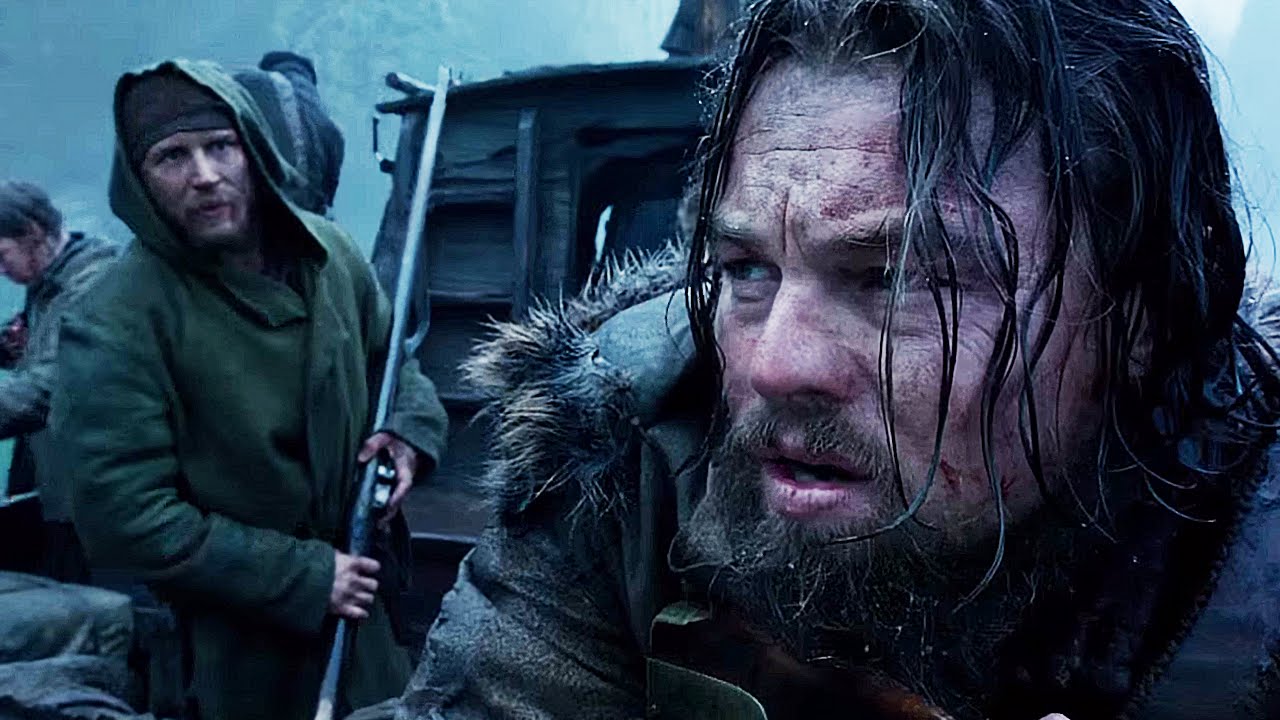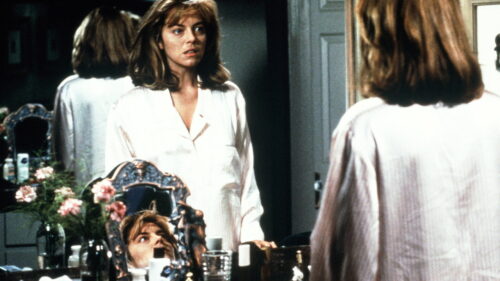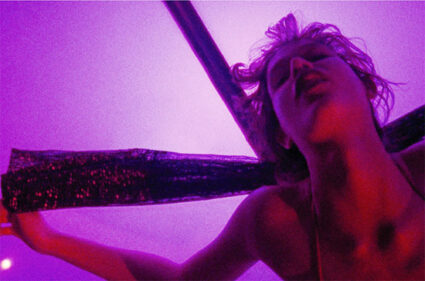“The Revenant” is the greatest Man Cave movie of the last ten years, made to be viewed from a black leather sofa. I saw it in a theater because I had a rare kid-free evening and was in the mood for a big-screen spectacle. I hesitated at the ticket window because the same theater was playing “Hail Caesar” and a part of me thought it might be better to see something funny. To my surprise, “The Revenant” scratched both itches. It’s so ridiculously macho that parts of it are hilarious, in the way that certain R-rated 1980’s action films starring Arnold Schwarzenegger or Sylvester Stallone are hilarious. It is, rather paradoxically, both austere and extravagant, embracing a highly concentrated, at times minimalist visual aesthetic while piling on the machismo. There are only two women characters in the film of any note; one is dead and appears as a hallucination or ghost, and the other is raped by a French trapper and then turns the tables with the hero’s help and slices off his testicles with a dagger. In one scene, the movie’s hero cauterizes a wound with gunpowder and fire, like Rambo in “Rambo III.” “The Revenant” is so manly that it becomes parody of manly movies and then somehow travels around the bend to become sublime before becoming ridiculous again. The process repeats itself for two-and-a-half hours, through gunfights and knife fights and animal attacks and avalanches and the like.
The movie is directed and co-written by Alejandro González Iñárritu, the multiple Oscar-winning director of “Birdman” and the only director more likely than David Fincher to technically over-complicate things to such a perverse degree that the resultant movie becomes at once dazzling and monotonous. Leonardo DiCaprio plays a real-life frontier survivor, Hugh Glass, a widowed fur trapper and single father who was on an expedition through Montana and South Dakota in 1823 in the company of his half-Pawnee son when he was mauled by a bear. Tom Hardy plays the betrayer Fitzgerald, who murders Glass’ son and leaves Glass to die of his wounds in a freshly dug grave.
“The Revenant” is a Leonardo DiCaprio film through-and-through, boasting
most of the elements we’ve come to associate with his star vehicles: he
plays a slightly aloof and mysterious character who is haunted by
visions of a dead mate and traumatized by past experiences with violence
(often the two experiences are combined, as is the case here) and
proves his manhood through feats of endurance, by suffering mightily, or
simply by remaining autonomous long past the point where one might
reasonably expect his character to have given up, collapsed from
exhaustion, gotten murdered by enemies, etc. Glass might be the ultimate version of
this DiCaprio hero, the apotheosis, the Big Kahuna. He gets
symbolically killed multiple times throughout the “The Revenant,” starting with
the bear attack and continuing on through his betrayal by Fitzgerald
(there’s even a shot of Glass’s gnarled hand rising out of the dirt) and then through his miraculous
survival of a blizzard (inside a carapace made of tree branches, by a Native
American who respects Glass’s tenacity and gets murdered by French trappers
in the very next scene).
The real Glass eventually recovered in subzero temperatures and sought revenge. This synopsis makes the film sound like a long-lost Clint Eastwood picture, about a monosyllabic gunfighter who is symbolically or actually killed and then raised from the dead to exact vengeance on his tormentors. “The Revenant” might have made a good Clint film, though surely nowhere near as visually audacious as the one envisioned by Iñárritu. He and his regular cinematographer, Emmanuel Lubezki, shoot the entire movie in available sunlight and firelight, usually through a super-wide-angle lens that keeps the characters in the foreground and the landscapes in the background in sharp focus while creating a bit of a gargoyle effect (distorting faces into ovals). The camera is never in what most directors would consider a typical place, and Iñárritu never cuts unless he has to. A lot of the time you’re watching a closeup of somebody either speaking or listening while the camera leaves lots of negative space screen left or right, or creeps slowly around them. These are horror movie strategies that prime you to expect a threat to emerge from off-screen, from behind the obstruction that is the character’s face, or from the background. It’s the correct approach for what is, in its heart, as much a horror film as a survival story.
The instantly notorious bear attack sequence is staged using the third approach: threat emerging from background. The bear charges out of the bushes and lays into Glass for what feels like an hour (though it’s really just a few minutes), dragging him, clawing him, biting him, stepping on him, fogging up his eyeballs with his stinky bear breath. Like nearly every other scene in the movie, this one is staged as a bit of primal theater, Werner Herzog by way of Looney Tunes. As my friend Keith remarked, this is a movie about a man who tries to survive nature’s multiple attempts to murder him. Remember how your high school literature teacher taught you that one of the basic stories is Man vs. Nature? Well, this one is Nature vs. Man. A lot of the time, the best Man can do is hunker down and pray. Glass drags himself across frozen tundra despite a bum leg and ghastly wounds, hurls himself down icy river rapids to escape Native American trackers, survives another Native American attack by riding a horse off a cliff and into a tree and then guts his dead horse and climbs into its carcass to survive yet another snowstorm.
The latter scene, too, is somehow simultaneously awesome and hilarious—awesome because, by that point, we are rooting for Glass to survive by any means at his disposal, and ridiculous because the film often plays like a tall tale about a frontier legend along the lines of Paul Bunyan or John Henry—a man so driven that he slaps Death’s icy hand away and calls it a sissy. The scene where Glass guts the horse is a scene of caveman-level instinctual mammalian brutality and also perhaps one of the great moments in motion picture history illustrating the rich heterosexual actor’s traditional, deep-seated fear that he is engaged in an insufficiently masculine profession, and needs to somehow compensate for that; as the camera circles slowly around the horse carcass, as Leo removes the animal’s interior and then takes his clothes off and climbs inside, you may be struck by the fact that you’re essentially watching yet another birth or re-birth scene (inverted) and also something very similar to the only great moment in “Ace Ventura 2: When Nature Calls”: the scene where Jim Carrey’s character for some godforsaken reason appears to observers to be “born” through the anus of an audio-animatronic rhino. There’s a scene in this movie where Glass traps a raw fish and bites its head off while it’s still visibly flopping around, and another where he tears a frost-covered elk skeleton apart and sucks the marrow out of a vertebrae. You feel pretty sure there’s some fakery involved in these scenes and others, but DiCaprio seems so into the chewing and tearing and gnawing that you wouldn’t want to place any bets.
At the end of the film, when Fitzgerald and Glass face off, shooting and stabbing and grappling and cursing at each other while Lubezki’s camera lunges towards them, practically piling onto them like a third combatant, the fight is so intense and the amplified impact-splats and drizzly-blood noises and Hardy’s borderline unintelligible Yosemite Sam mutterings are all so loud that the scene tips over into slapstick comedy, and by no means for the first time. There’s an odd black comedy streak running deep beneath the surface of “The Revenant,” but it’s hard to spot because it’s buried beneath Lubezski’s Terrence Malick-with-chest-hair camerawork and Ryuichi Sakamoto’s mournful, often atonal score, which apparently was performed by the Hard to Be a Man Orchestra. It is an incredible experience, a pulpy action movie in quasi-mystical peyote western drag, devoid of anything resembling a predictable image, and never dull (unless you’re bored by the very idea of a movie like this, in which case it’ll be misery). I could have watched it for another hour and not grown restless, though I would’ve reserved the right to continue finding it funny, and to not particularly care whether the laffs were intentional or accidental.
“The Revenant” seriously stumbles, though, during its last twenty minutes, which set up that entirely predictable climactic man-to-man combat between Glass and Fitzgerald. The fight resolves itself in what the film wants you to think is a moment of enlightenment for Glass but that is more the equivalent of the CIA claiming they don’t torture prisoners when they actually subcontract it to other countries. The real-life ending of Glass’ story would’ve made for a surprising, even subversive finale: after all that misery, he finally tracked down his betrayer but couldn’t kill him, because by that point Fitzgerald had enlisted in the army, and the army wouldn’t allow a civilian to execute a soldier. According to HistoryNet, “Glass had to be satisfied with the knowledge he’d shamed his betrayer, a
purse collected by sympathetic troopers, and the solid weight of his
rifle again in his hand.”












